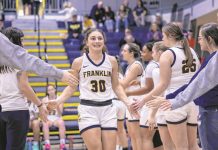It’s a frigid Tuesday evening in February, and the ice is dotted with a half dozen or so hockey coaches and roughly 30 young players of varying heights.
Some have grown into their equipment. Others look a bit more like the young Darth Vader from that car commercial — an oversized helmet on a not-so-oversized body.
All of the players, ranging in age from 4 to 8 years old, appear to be having a blast.
The air, which isn’t much warmer on the ice than it is outside, is filled with a hint of that distinct odor — aged sweat soaked into foam padding.
It smells like hockey.
Such a scene is commonplace in Minnesota or Massachusetts, where many children learn to skate and handle a stick not long after they’ve mastered walking. It’s not something you expect to see in Indiana.
Yet the Hamilton Ice Arena is packed like this twice a week with some three dozen little hockey nuts and their parents.
A rebuilding process
It wasn’t nearly this busy here a year ago. The mite hockey program, which is run by the city’s Parks & Rec department, was down to about 10 or 12 kids last winter. Without some sort of infusion of new blood, the program was in danger of becoming unsustainable.
Much of the problem was perception. Unlike soccer or basketball, which kids can take up without much up-front cost, hockey can be a pretty expensive undertaking.
Eric Howe, one of the program’s head coaches, heard the rumblings when he was out at the soccer fields last year trying to recruit new players.
“I was just kind of go around and listening to some of the conversations that were going on,” he recalled, “and they were all around, ‘Hockey’s too expensive, it takes up too much of your time, there’s too much travel,’ and it was all these negative connotations to it.”
In an effort to eliminate some of the negatives, the program invited local parents to bring their kids to the rink for a free trial run. Thanks to a grant from USA Hockey, there is enough equipment available for anyone in the mite age group who wants to take up the sport.
“I have not paid for any equipment,” said Joni Dugner, whose 7-year-old son River got hooked during his first Try Hockey for Free session last spring. “The only thing that we spent money on was a stick, and it wasn’t because he didn’t have one. He had one. He was just kind of ready to graduate to a curved stick, so we went and bought him a curved stick for 40 bucks.”
Dugner offered to give the equipment back and buy River his own once she knew he wasn’t going to quit, but she was told no.
According to Howe, there’s plenty of equipment to go around, and the more kids that get involved, the more equipment USA Hockey will provide. The hope is that if parents aren’t scared off by the startup costs, they’ll be more willing to let their kids come out and try it.
In theory, once the children get on the ice, they’ll be hooked.
Can’t get enough
In practice, that theory seems to be holding up. Many of the kids who took advantage of the free trial runs last year came back and joined the program this winter. The numbers have just about tripled, with nearly 40 players now playing mite hockey.
“We tell friends that we’re playing hockey, and they look at you funny, because it’s not a sport you hear about in Indiana,” said Scott King, who brings 8-year-old Carson down from Franklin to play. “But if you just get the kids to come out and teach them to skate — and that’s really the biggest part, is teaching them to skate — then they start learning hockey, you can’t get them off the ice.”
That growth is exciting, coach Dave Weed says, but it’s still not enough for a sustainable program.
Even with more than 30 players at the mite level, he explains, that means roughly seven or eight players for each calendar year. There is almost always some natural attrition as kids get older, whether it’s losing them to other sports or some other activity.
Columbus Youth Hockey has travel teams starting at the squirt (ages 9-10) level up through high school — but its house league has fewer than 10 players total.
“It’s pretty much you either move to travel or you basically stop playing, and we don’t want that to happen,” Weed said. “If they want to continue to play but they don’t want to play travel, we want that to be a viable option.”
Breaking down barriers
In order to keep numbers high enough to maintain Columbus Youth Hockey teams for ages 9 and older, there need to be more boys and girls getting involved in the Parks & Rec program at a younger age.
With many of the traditional barriers to entry now broken down, it should be easier to lure new hockey players in and keep them around. Weed estimates that the retention rate from last year’s Try Hockey for Free sessions was close to 50 percent.
Stefan Bergmann brought his 5-year-old son Kai to one of the trial dates last year, and they’ve been coming back ever since.
“I never would have thought that my son is playing hockey,” Bergmann said, “but he loves it. … It’s amazing what they do here.”
“River doesn’t go to school with any of these kids,” Dugner added, “but these are all his friends now.”
In addition to having fun and making new friends, the players are building up a confidence that they can carry with them off the ice as well.
Dugner credits the coaches, who she says strike a good balance between challenging the players to improve and making sure they have a good time. She notes that since her son was able to start playing hockey, other seemingly difficult tasks haven’t seemed quite so daunting.
“What he has learned is that he can do really hard things, and it’s built a confidence in him that we haven’t seen before,” she explained. “Even when he’s doing homework and he gets frustrated, it’s like, ‘Give me a break. You skate 100 miles an hour on blades that are 1/8 of an inch thick. You can figure out this problem.'”
Weed and Howe hope that by making it easier for more families to get involved in hockey, they’ve figured out the solution to their problem as well.
[sc:pullout-title pullout-title=”If you go” ][sc:pullout-text-begin]
USA Hockey Try Hockey for Free
When: Saturday, Feb. 20, 10:45 to 11:45 a.m.
Columbus Parks & Rec Learn to Play Hockey
When: Saturdays (Feb. 27, March 12 and 19, April 2, 9, 16 and 23) 4:15 to 5:15 p.m. following the public skating session
Cost: $5 per session (equipment is free)
[sc:pullout-text-end]




